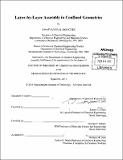| dc.contributor.advisor | Robert E. Cohen and Michael F. Rubner. | en_US |
| dc.contributor.author | DeRocher, Jonathan P | en_US |
| dc.contributor.other | Massachusetts Institute of Technology. Dept. of Chemical Engineering. | en_US |
| dc.date.accessioned | 2012-04-26T18:49:44Z | |
| dc.date.available | 2012-04-26T18:49:44Z | |
| dc.date.copyright | 2011 | en_US |
| dc.date.issued | 2011 | en_US |
| dc.identifier.uri | http://hdl.handle.net/1721.1/70397 | |
| dc.description | Thesis (Ph. D.)--Massachusetts Institute of Technology, Dept. of Chemical Engineering, 2011. | en_US |
| dc.description | Cataloged from PDF version of thesis. | en_US |
| dc.description | Includes bibliographical references (p. 142-149). | en_US |
| dc.description.abstract | The fundamental nature of layer-by-layer (LbL) assembly in confined geometries was investigated for a number of different chemical systems. The first part of this thesis concerns the modification of microfluidic and nanofluidic devices which hold great potential as a platform for manipulation and analysis of small sample volumes. The high throughput and high surface area possible with these devices suggests applications in biomolecule or chemical detection, selective separation, and heterogeneous catalysis. To realize some of this potential, the surfaces of these devices can be modified to impart functionality to the device. Polyelectrolyte multilayers can be used to impart a broad array of novel functionalities to a surface including stimuli-responsiveness, reversible switching of the gap thickness, manipulation of the sign and/or the density of the surface charge, chemical functionality and wettability of a surface. Polymer/polymer, polymer/nanoparticle, and nanoparticle/nanoparticle multilayers have all been deposited in confined channels. In all cases, conformal uniform multilayers were observed throughout the high aspect ratio channel. LbL assembly within submicron channels does, however, reveal a number of interesting departures from what is seen for LbL growth on infinite planar surfaces and we explain this effect by surface charge-induced depletion of the adsorbing species in the confined channel at each stage of the assembly process. At sufficiently low ionic strengths, this exclusion prevents further deposition on confined surfaces while adjacent unconfined surfaces continue to be coated. Nanoparticle/nanoparticle deposition results in systematic bridging of the nanochannels with a nanoporous multilayer. This fundamental knowledge was applied to the systematic narrowing of nanochannels embedded in a hybrid micro/nanofluidic device using LbL assembly of polyelectrolytes. The narrowing of these channels was monitored using conductance experiments and showed that the channel thickness could be controlled down to 11 nm. Understanding of exclusion was used to modify track etched polycarbonate membranes in an attempt to build composite membranes which exhibited high salt rejection and high water permeance. These membranes were compared with theoretical models and with commercially available reverse osmosis membranes. | en_US |
| dc.description.statementofresponsibility | by Jonathan Paul DeRocher. | en_US |
| dc.format.extent | 164 p. | en_US |
| dc.language.iso | eng | en_US |
| dc.publisher | Massachusetts Institute of Technology | en_US |
| dc.rights | M.I.T. theses are protected by
copyright. They may be viewed from this source for any purpose, but
reproduction or distribution in any format is prohibited without written
permission. See provided URL for inquiries about permission. | en_US |
| dc.rights.uri | http://dspace.mit.edu/handle/1721.1/7582 | en_US |
| dc.subject | Chemical Engineering. | en_US |
| dc.title | Layer-by-layer assembly in confined geometries | en_US |
| dc.title.alternative | LbL assembly in confined geometries | en_US |
| dc.type | Thesis | en_US |
| dc.description.degree | Ph.D. | en_US |
| dc.contributor.department | Massachusetts Institute of Technology. Department of Chemical Engineering | |
| dc.identifier.oclc | 783860895 | en_US |
